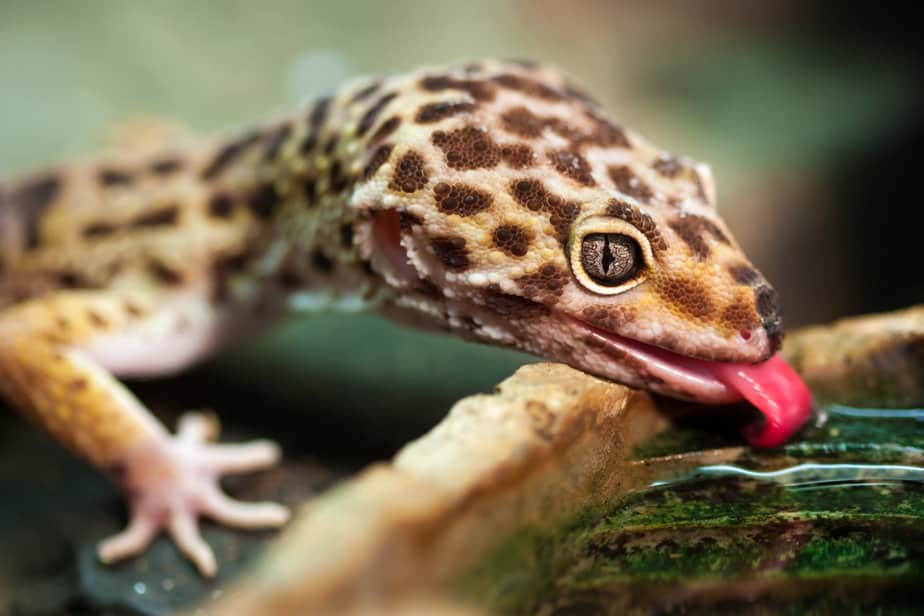You’ve welcomed a delightful leopard gecko into your home, and you’re ready to provide the best possible care for your new scaly friend.
Naturally, questions about their needs arise, and one that might have you curious is, “Do leopard geckos drink water?”

This article aims to address this question, offering insights into the hydration needs of your fascinating little reptile.
So, buckle up, and let’s dive into the world of leopard gecko hydration, uncovering the secrets to keeping your tiny companion happy, healthy, and well-hydrated!
Do Leopard Geckos Need Water?
Leopard geckos do drink water, but not as frequently as other pets. Leopard geckos obtain most of their moisture from food, particularly insects containing water. However, it is still important for leopard geckos to have access to water to maintain their overall health.
Leopard geckos drink water either by either lapping it up (like a cat) or by licking moisture from objects within their enclosure.
Providing a shallow dish of fresh, clean water is essential for a leopard gecko’s well-being, as they can barely survive more than 72 hours without it.
Not all tap water suits leopard geckos, as some areas might have compromised water quality.
In such cases, it might be necessary to treat the tap water before offering it to your gecko.
You shouldn’t give distilled water to your gecko, as it lacks essential natural salts needed for osmotic regulation, which plays a crucial role in their physiological processes.
How Often do Leopard Geckos Drink Water
The frequency of a leopard gecko’s water intake can vary based on factors such as their environment and the amount of moisture they receive from their food.
Some geckos may need water every 2 to 3 days. In contrast, others may go longer periods without needing a drink, especially if they are misted regularly and can lick water droplets from their surroundings.
How Do Leopard Geckos Drink Water? (Hydration Sources)
Providing proper hydration is crucial for your leopard gecko’s overall health. In this section, you will discover various hydration sources that can help maintain your pet’s well-being.
Water Dishes
While leopard geckos do not require a large amount of water, providing a shallow water dish with clean water is essential.
This allows your gecko to drink water whenever needed. Ensure you use a water bowl that is easy to clean and safe for your leopard gecko to drink, such as filtered or treated tap water.
Position the water dish near the warmer side of the enclosure, as this encourages your leopard gecko to drink more. Your leopard gecko will also use the dish for bathing.
Misting
Another hydration source for your leopard gecko is water droplets created through misting. Misting the tank occasionally will create droplets of water that your gecko can lick to get additional hydration.
This method also helps maintain a suitable level of humidity in their environment. Don’t mist the tank too often, as it could lead to excessive humidity, which may harm your pet.
Moist Hide Boxes
Providing a moist hide box in your leopard gecko’s habitat is essential. Moist hide boxes serve as a hiding place and help your gecko maintain its hydration level.
During shedding, a moist hide box aids in removing old skin by keeping it moist and easy to peel off.
To create a moist hide box, fill a small container with damp sphagnum moss or eco earth, and place it in a warm tank area. Regularly check the substrate to keep it damp and clean.
Incorporating these hydration sources in your leopard gecko’s habitat ensures your pet stays healthy. Remember to monitor the water dish and your pet’s overall water intake to adjust as needed.
Monitor your Gecko’s Hydration
Keep an eye on your leopard gecko for signs of dehydration, such as wrinkled skin, sunken eyes, or lethargy.
If you notice these symptoms, take action by soaking your gecko in lukewarm water and misting the enclosure more frequently.
Signs of Dehydration in Leopard Geckos
Dehydration in leopard geckos can occur due to various reasons, such as inadequate water supply or an inability to retain moisture.
Identifying the signs of dehydration early is crucial to keep your gecko healthy and hydrated. Here are some common symptoms to look out for:
- Sunken eyes – Healthy geckos have slightly protruding and clear eyes
- Dehydrated geckos might show flat or slightly concave eyes
- Irregular shedding
- Skin appears dry, flaky, or wrinkled
- Puckered or wrinkled skin indicates that your gecko needs more moisture
- Sticky mucous membranes in the mouth lining and dry, ropy saliva
If you observe any of these symptoms in your leopard gecko, it is essential to address the issue to prevent further complications.
Maintain a proper water supply and monitor your gecko’s environment to ensure they remain healthy and hydrated.
